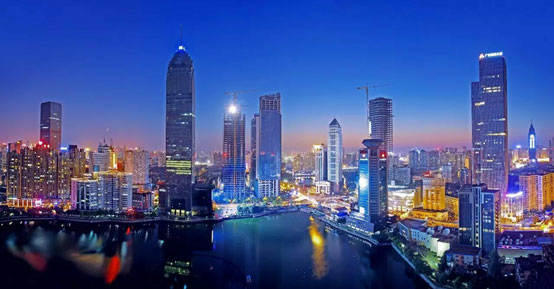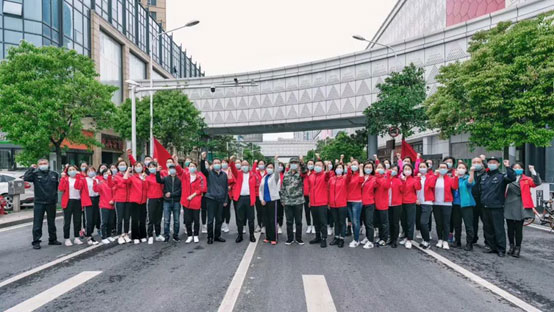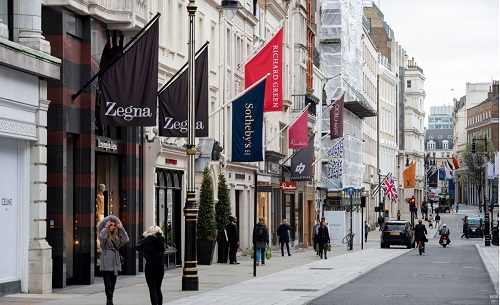FW
The postponed March edition of Chic Shanghai will shifted in Shenzhen in July alongwithr with Chic's Shenzhen debut event.
Due to the global Corona epidemic, the fashion and lifestyle fair could not be held as planned March 11-13 in Shanghai. Since the ongoing worldwide epidemic situation does not allow China's control and prevention measures to be relaxed, organisers did not see a chance to have a catch-up date of Chic's March edition to be held in Shanghai in the next weeks due to logistical reasons.
The originally planned event space for the premiere of Chic Shenzhen from July 15-17 will be expanded by 10,000 square meters to 40,000 square meters.
The China National Textile and Apparel Council's Greater Bay Textile & Apparel Expo will now combine a total of four trade shows in Shenzhen: Chic Shenzhen, Intertextile Shenzhen Apparel Fabrics, PH Value and Greater Bay Area International Trade Fair for Fibers and Yarns.
All Chic product areas will be realised in halls 9 and 11 of the Shenzhen World Exhibition & Convention Center including Tailoring, Urban View, New Look, Impulses, Kidz, Chic-Young Blood, Chic Worldwide (international participation) in Hall 9 and Denim World, Secret Stars, Bags & Shoes, Heritage, ODM in Hall 11.
According to the The World Trade Organization, overall global trade is likely to drop between 13 and 32 percent due to the crisis. World trade volume in goods, including apparel and textiles, is forecast to drop between 13 and 32 percent this year due to the coronavirus pandemic, the World Trade Organization said Wednesday.
The pessimistic scenario of a 32 percent or more drop assumes a steeper initial decline and a more prolonged and incomplete recovery. Regarding global trade in goods last year, the value fell by 3 percent to $18.88 trillion, with the world’s top exporter, China, registering no growth at $2.49 trillion, followed by the U.S. with a 1 percent contraction to $1.64 trillion and Germany with a 5 percent fall to $1.48 trillion.
In apparel, preliminary estimates by WTO economists indicate the value of exports stagnated in 2019, with almost zero growth from the $494 billion notched in 2018. In 2019, WTO data show, China, the world’s biggest apparel exporter, registered a 4 percent decline to $151.5 billion. In the first two months of 2020, China’s exports of apparel (according to customs data) were down around 20 percent year-on-year, the WTO said. Neighboring Vietnam posted a 9 percent increase in 2019 to $30.8 billion.
Jeanologia has repurposed its ozone based G2 technology, which it uses for the sustainable treatment of jeans into an innovative method for sanitisation and disinfecting face protection masks.
Considered an “essential” business by the Spanish government during the COVID-19 crisis, the company is making a great effort, working together with other technology centers and universities in coordination with the government, and acting altruistically. Enrique Silla, Jeanologia’s founder, has that “after Covid19 eco-sustainable production will become obligatory for everyone. Only the companies that have put people and planet before profits and have a purpose will be able to survive.
For the sanitisation process, Jeanologia takes the face protection masks to be disinfected and pust them into a hermetically sealed chamber – Sanitizing box – subjecting them to a determined quantity of ozone. Through advanced oxidation the bacteria is eliminated and the material is disinfected.
The disinfection protocol is certified by the Valencian government’s health authorities and complies with international health and safety specifications. The brand will continue working in this direction with its R+D team because the sanitisation of apparel and workwear is demanded by brands and consumers.
The Kingpins New York denim trade show originally scheduled for June 2-3, 2020, will not take place due to health concerns and travel restrictions related to COVID-19.
Kingpins has recently launched Kingpins24, a new online event for the denim industry that will debut on April 22/23 and represents its organisers' attempts to unite and inform the denim industry in these uncertain times. The next regular edition of Kingpins New York is scheduled for November 17-18.
Turkish Clothing Manufacturers Association (TCMA) has urged global brands to act in unity with their strategic partners, garment manufacturers, to get through tough times.
In the face of COVID-19, emerging threats to the global economy raise concerns for the ready-made garment industry in Turkey. This industry has sustained the retail operations of global brands for the past century by offering garments with the highest quality, paired with innovative collections and the fastest delivery. When governments declared lockdown for societies due to health and safety reasons, global brands' reaction was to close down retail stores all around the world due to the sudden decline in sales. As a result of losses in sales, volume and revenue, brands then turned to their suppliers with a number of defensive measures which have severely harmed the garment manufacturing industry employing over 1.5 million people in Turkey.
According to the hundreds of messages expressing concerns and complaints directed at “TGSD Coronavirus Help Desk” over the past four weeks, suppliers have drawn attention to some of these alarming actions taken by global brands and retailers:
A large number of brands declared to the manufacturers that there will be no future orders until further notice. This will oblige manufacturers to cover labor and overhead costs on their own for an indeterminate period of time. Some brands called for the suspension of production in the pipeline and yet in some rare cases, solicited discounts or cancellations for goods are in the pipeline.
Lastly, some brands request an extension on the payment terms for shipped goods that are on their way to distribution centers or already in the stores.
Hanzheng Street in Wuhan is home to 12,000 business shop owners running wholesale in 54 markets there with a total annual turnover for approximately 100 billion Yuan. The wholesale center for apparel brands is the cream of the crop, 60% of the annual turnover comes from the apparel wholesale in these famous sell-and-buy hubs. The center as wholesale for apparel brands is as large as 300,000 square meters with over 3000 brands apparel, in category mainly of menswear, women’s wear, kids wear, leisure wear and various kinds of apparel accessories.
Wuhan, the super-large metropolitan city in the midstream of Yangtze River, reopened on April 8, to the public after a 76-day- long lockdown for its epicenter of the novel coronavirus outbreak in China. As the capital of Hubei province, the city is also known in the country for high-speed railway transportations all for about 5 hours respectively to Beijing, Shanghai, Chongqing, Shenzhen and Hong Kong, in addition to its pivot in the central provinces for over 40 international direct air routes that cover four continents in the world.

Wuhan, recently known for being an epicenter of Coronavirus, was hit the hardest in China, perhaps in the world on a single city count. As on April 10, the confirmed cases of COVID-19 in Wuhan city added up to 50,007 since its first case was reported at the end of last year, accounting for 73.75% of Hubei Province where the aggregated confirmation of the disease infections amount to 67,803 cases, which has a lion-share at 81.39% of the country for 83,305 cases in total. This is only a historical trend of data in the course of the disease control and prevention footprints, and the city is being opened up on the grounds that there has been growing no new infections for nearly a month with 47,085 patients fully recovered after a tragic loss of 2575 lives, leaving the rest of 347 patients still being hospitalized for further medical care.
As now, incoming and outgoing transportation restriction has been lifted; the city is back to life step by step, leaving no loopholes for safeguarding the hard-won victory. Businesses start to tick up, shops are opened, retails and wholesales are attracting buyers in busy shopping streets, and the famous Hanzheng Street is on the headline of the press because it has been a time-honored business rendezvous, a cluster of retail and wholesale streets, buildings and thousands of shop windows offering everything but arms to sell or buy, textiles and apparel are the earliest known there, and perhaps the bulk of businesses as a whole.
Back to the early years of the 20th century, the foreign powers carved Hankou, one of the three river towns (China’s longest river Yangtze River has concurrent with its largest tributary here to split the central city into three towns) into concession and built up shopping street in the Foreign Settlement at that time, and Hanzheng Street gradually morphed into a shopping center. In 1979 when China started to practice economic development-centric reform and opening policy, this street got reinstated to be Retail and Wholesale Market for Small Commodities, the same market status as Yiwu market center in Zhejiang province, which international buyers seem to know better.
 |
| shop owners are welcoming business back to life in Hanzheng Street |
Hanzheng Street in Wuhan is home to 12,000 business shop owners running wholesale in 54 markets there with a total annual turnover for approximately 100 billion Yuan. The wholesale center for apparel brands is the cream of the crop, 60% of the annual turnover comes from the apparel wholesale in these famous sell-and-buy hubs. The center as wholesale for apparel brands is as large as 300,000 square meters with over 3000 brands apparel, in category mainly of menswear, women’s wear, kids wear, leisure wear and various kinds of apparel accessories.
According to the Textile and Apparel Retail and Wholesale Committee of China National Textile and Apparel Council, its latest report of market prosperity indicators shows that the March 2020 witnessed Market Managers Prosperity Indicator (MMPI) at 51.24, up by 35.11 percentage points over the figures in the survey all through January and February that were staggering at 16.13, and the Tenants Prosperity Indicator (retailer and wholesaler who rent the booths inside the textile and apparel shipping building) went well along with the former to arrive at 51.18, up by 14.78 percentage points over 36.40 reported in the first two months in the beginning of the new year.
CNTAC’s Retail and Wholesale committee issues an annual report for market prosperity analysis by keeping eye on 45 important bricks and mortar apparel-specific shopping centers or specific markets for understanding the textile and apparel markets in China. The Market Report 2018 shows the sale achievements in these 45 centers located in different areas of the country, for 996.299 billion Yuan in the east, up by 7.23% to take up overwhelming share of the totality by 82.39%, and for 145.036 billion Yuan in the central area to account for 11.99% of the total, up by 7.06%, and for 68.009 billion Yuan in the west of the country to represent 5.62% in cake share, with a drop by 3.32%.
Contributed by Mr. ZHAO Hong
He is working for CHINA TEXTILE magazine as Editor-in-Chief in addition to being involved in a plethora of activities for the textile industry. He has worked for the Engineering Institute of Ministry of Textile Industry, and for China National Textile Council and continues to serve the industry in the capacity of Deputy Director of China Textile International Exchange Centre, V. President of China Knitting Industry Association, V. President of China Textile Magazine and its Editor-in-Chief for the English Version, Deputy Director of News Centre of China National Textile and Apparel Council (CNTAC), Deputy Director of International Trade Office, CNTAC, Deputy Director of China Textile Economic Research Centre. He was also elected once ACT Chair of Private Sector Consulting Committee of International Textile and Clothing Bureau (ITCB)
Ramesh Poddar, Chairman, Siyaram
 “Definitely there is an opportunity for India as everyone will look for an alternative source. Hence, if we are able to exploit this chance, then definitely there is a possibility for India to be the next sourcing hub. China on the other hand has the advantage of bulk production and to get that kind of advantage and to come to their cost structure will take time though our labour costs are comparatively the same and the advantage they have is of mass scale production. I feel India should take this challenge and fill the gap.”
“Definitely there is an opportunity for India as everyone will look for an alternative source. Hence, if we are able to exploit this chance, then definitely there is a possibility for India to be the next sourcing hub. China on the other hand has the advantage of bulk production and to get that kind of advantage and to come to their cost structure will take time though our labour costs are comparatively the same and the advantage they have is of mass scale production. I feel India should take this challenge and fill the gap.”
What is the current status of garment and textile industry in India due to the lockdown?
The operations in garment and textiles industry are at standstill due to lockdown. There is very little scope of work from home in our kind of industry. We feel India is attempting a better control of situation due to delayed entry of Coronavirous in India and thoughtful leadership of our Prime Minister. We hope things will resume after the 21 days’ lockdown in most of the states however some states look concern. The times ahead will pose some tough challenges to every industry including us.
Are recent happenings an eye opener for all countries not to depend only on one source namely China? Does India have the capability to fill China’s space?
Definitely there is an opportunity for India as everyone will look for an alternative source. Hence, if we are able to exploit this chance, then definitely there is a possibility for India to be the next sourcing hub. China on the other hand has the advantage of bulk production and to get that kind of advantage and to come to their cost structure, we will take some time. Though our labour costs are comparatively lesser but they have advantage of economy of scale and some pro industry government policies. I feel India should take this challenge and fill the gap.”
What steps has Siyaram as a group has taken to overcome the current situation?
At present, like everyone else we are at a standstill. We have engaged our teams to prepare for future developments and planning. Fortunately, we have got some time for important but not urgent things as known to be the 2nd quadrant of TIME MANAGEMENT theory… we are utilizing this time in planning, strategising and skill building of our key resources for the future. We can only work for the future as everything else is at a standstill now.
What measures has Siyaram taken for its workers?
We have paid full salaries to our workers for the month passed, we expect the lockdown to release soon and we get going to create value for ourselves and for the country.
Do you feel, the government has done enough for the textile industry during this challenging time? What are your expectations?
In the present situation, the government is trying its best to give relief and the industry will want to get maximum package but we need to think of how much the government can give practically. Specifically, we cannot say what package the government should give but if they give a realistic deal that eases doing business it would be helpful. Our industry associations are taking up the matter suitably with the government.
What is your advice to the textile industry in this situation?
My advice is to utilize this important time in a positive manner with family.
Also utilising to upskill your key resources through dialogs and some good training contents. Keep the team engaged and interact on daily basis to be on the same page.
Work and think of the future as these 21 days will have a lot of stories in the times to come. During this period think positive, don’t watch negative news or spread negative forwards. Spend quality time with family and keep taking care of everyone’s well-being
 This edition of Shanghai Fashion Week was not the usual cluster of white tents found at the city’s Xintiandi retail hub. Instead, the entire event was facilitated by Alibaba’s e-commerce platform, Tmall. This online event meant business, and amplification was a key objective. The Taobao platform has an overall reach of over 711 million active users, meaning all brand viewing figures increased massively in the most extensive “see now, buy now” demonstration from a fashion week to date. Viewing figures reached 2.5 million over the three-hour opening session alone. Cities with the most viewing areas were identified as Shanghai, Beijing, and Chongqing, coming from a mostly female demographic.
This edition of Shanghai Fashion Week was not the usual cluster of white tents found at the city’s Xintiandi retail hub. Instead, the entire event was facilitated by Alibaba’s e-commerce platform, Tmall. This online event meant business, and amplification was a key objective. The Taobao platform has an overall reach of over 711 million active users, meaning all brand viewing figures increased massively in the most extensive “see now, buy now” demonstration from a fashion week to date. Viewing figures reached 2.5 million over the three-hour opening session alone. Cities with the most viewing areas were identified as Shanghai, Beijing, and Chongqing, coming from a mostly female demographic.
The event ensured that all the designers and brands had a voice this Fall 2020. It also aimed to facilitate sales for commercial brands. Robert Huo, General Manager of womenswear of Tmall Fashion says, of over 150 brands participated in the event. As a co-host, Tmall extended commercial recognition to a wider range of independent designers via the local fashion incubator Labelhood. As the partner of Shanghai Fashion Week, Labelhood funneled brands through its verified Tmall store while alternative virtual retail stores, such as Xintiandi pop-up, were also used by labels as a way of capturing sales during the week-long event.
More than sales focused event
Throughout the week, different strategies and personalities shone through as each brand put their own spin on the SNBN model. Most independent designers on the Labelhood platform used their slots in a more experimental rather than sales-focused manner.
designers on the Labelhood platform used their slots in a more experimental rather than sales-focused manner.
Shushu/Tong’s co-founder Liushu Lei made their video presentation look like a show, which was played on repeat for the full length of their allocated slot. Other brands such as Ffixxed Studios used the opportunity to play with the concept of the livestreaming show. Kain Pickering and his partner Fiona Lau had doubts around how to balance branding and sales aspect, while authentically reflecting the brand’s ethos. Menswear duo Private Policy’s livestream selected Mia Kong, style director of Dazed China, to host its livestream — opting for a KOL which they felt best reflected their DNA.
Livestreaming facilitates instant communication
Livestreaming brought an additional change this season: instant communication with active consumers. Sessions saw hosts address live questions, mostly focused on issues like styling and fabrics. This feedback could be digested in real time by the designer who was then free to engage and make instantaneous responses.
A pathway for exposure
For many designers, the event was a gateway for massive exposure, in particular for relatively unknown talents, and video was the perfect avenue to connect with new customers. A creative video by a young label, Fabric Porn, proved particularly popular on Tmall. The experience was set in a hazy abandoned house and recalled the New York underground music scene. It was during the livestream that founder Zhao Chenxi really excelled.
Dazed China’s Kong continued livestreaming as people were craving to see celebrities’ personal life up close. The Tmall livestream format presented both a spike in exposure and in sales. Homegrown luxury player Icicle, for one, earned over 238,000 views within the two hours livestream; visitors as well as sales on its Tmall store increased 100 per cent. Icicle attributed the commercial success of its “see now, buy now” showcase to their choice of product — selected commercial lines were promoted over conceptual pieces.
Fashion conglomerate Zuczug, with over 100 stores and six fashion lines, says all their data doubled. In particular, the number of interactions between the audience and them increased reached above 100,000. The Shanghai-based co-founder proved as a necessary virtual outlet for designers struggling to cope post COVID-19 and allowed designers to advance their understanding of 3D design and application and audience engagement.
R K Agarwal, Chairman, Telangana Spinners Association
 “Not only India and but the entire world is realizing, we need to have alternate supply sources. Indeed, this is a big eye opener for everyone more so for us since we are in competition with China. There is nothing that stops us from creating large capacities where we will be able to cater to the world’s requirement in various segments, and fulfill the entire value chain in apparel and the downstream industry. I am sure, many entrepreneurs will come forward to assess the pitfalls we are going through and the lessons learnt from them. In future, some investments will go through in fabric and other raw materials that we are sourcing from China. We need to learn from this and push ourselves to be self-dependent.”
“Not only India and but the entire world is realizing, we need to have alternate supply sources. Indeed, this is a big eye opener for everyone more so for us since we are in competition with China. There is nothing that stops us from creating large capacities where we will be able to cater to the world’s requirement in various segments, and fulfill the entire value chain in apparel and the downstream industry. I am sure, many entrepreneurs will come forward to assess the pitfalls we are going through and the lessons learnt from them. In future, some investments will go through in fabric and other raw materials that we are sourcing from China. We need to learn from this and push ourselves to be self-dependent.”
What challenges are being faced by the industry today and how to overcome them?
The Prime Minister’s decision to lockdown the country was very timely. Looking at the intensity of the pandemic and the challenges the entire world is going through, it was required. The prime importance should be to provide food, medicines and healthcare. Under these circumstances, the textile industry and the entire value chain except a few home segment and those related to medical textiles, are facing many challenges. These challenges are likely to remain for the next 6 to12 months. We have to be prepared to face this for a long time and find ways and means to overcome them.
The crisis could also hold some opportunities, like many apparel makers could switch to making personal apparels at this point as there is a huge demand. Hospitals too require many textile articles like bed sheets, towels etc, probably this area can be looked into. Almost the entire world is in a lockdown and predictions are the economy will move to a negative zone; probably India’s GDP will slide to 2 to 3 per cent. A lot of orders are being cancelled particularly for apparels. Most global brands are cancelling orders for the next 6 to 12 months. So, these are challenging times and we appeal to the government to help and support the industry.
What challenges do you foresee in spinning segment?
We are a part of the value chain. It is only when apparel and other segments in the value chain start doing well and complete their orders, we come in and fulfill the value chain. Once there are orders for apparels, bed sheet, home textiles and other segments, order for yarns will start coming in. We are hoping for the best and preparing ourselves for these challenges. At the same time, we are representing to the government for relief that can help the industry in this time of distress.
Since the textile industry is very labor intensive particularly spinning and apparel, the big challenge is to retain workers and make their payments. Once the lockdown is over, and industry starts getting back to normal, we expect the domestic market to normalize faster than the international market.
India and most of the world depend on China for major sourcing, is this an eye opener, and can India emerge a sourcing hub?
Not only India and but the entire world is realizing, we need to have alternate supply sources. Indeed, this is a big eye opener for everyone more so for us since we are in competition with China. There is nothing that stops us from creating large capacities where we will be able to cater to the world’s requirement in various segments, and fulfill the entire value chain in apparel and the downstream industry. I am sure, many entrepreneurs will come forward to assess the pitfalls we are going through and the lessons learnt from them. In future, some investments will go through in fabric and other raw materials that we are sourcing from China. We need to learn from this and push ourselves to be self-dependent.
To make India the next sourcing hub, the biggest challenge we face is quality and pricing. Comment.
India can emerge if we are able to source the right technology and can produce in volume. China gets away with pricing because they are able to produce in volume. So they are able to reach economy of scale. We have been looking at that. Since we are able to source a little cheaper, we are not pushing ourselves to enter this space. Somebody needs to take the lead and start a volume segment and other things will start falling into place. As for quality, when you look at economy, you will also look for the best technology. Once you have the best of technology, I don’t think you will fall, it will be good automatically.
What has the government done for the industry and what are your expectations?
All textile associations have come on a single platform and made presentations to the government. Some have asked for a moratorium for a year on term loans and extending the working capital limit by about 25 per cent, which could be repaid over a time span of three years and some extra export incentives. We are looking for the state government to waive fixed charges particularly in electricity for the lockdown period or for three months. We are also looking at the Union government to come forward and support in sustaining labour so that they shell out about 50 per cent wages and the other 50 per cent is borne by the industry. Broadly these are the kind of help being contemplated by the industry. We are hopeful they will be granted as textile is the second largest industry after agriculture.
Is the Telangana government doing anything specific for the industry?
We have made a representation to them. The state government has always proactively supported the textile and the spinning industry. We have had discussions and they are seriously working on them. We shall have a response shortly. State governments have their own limitations and most issues are covered by the central government. The states cannot do much other than in the power sector. We have requested them to waive off fixed charges or charge for the actual electricity consumed for next three months as we don’t know for how long this will continue and how long it will take to recover.
How would the pandemic impact India’s textiles exports?
Garment exports will take longer since orders are cancelled virtually for six months. It will take a longer to recover the overheads from the international markets. As for yarn, we expect China to rebound earlier and as they have almost started working, we could see particularly cotton yarn demand coming from China. That could help the cotton yarn industry to a great extent. Bangladesh might also be of some help as we have information the apparel industry there have started working.
What is your advice to the industry during this challenging time?
The industry just needs to have a grip and commitment and hold on to as this also will pass and things will become normal. We need to be strong and are sure to overcome it.
 Even as brick-and-mortar shut down, fashion firms can position themselves for recovery when the COVID-19 pandemic fades, says a McKinsey study. However, to achieve these objectives, firms need to first protect their people, manage cash, review in-year inventory positions and assess the supply chain, amplify digital initiatives, and maintain connections with consumers.
Even as brick-and-mortar shut down, fashion firms can position themselves for recovery when the COVID-19 pandemic fades, says a McKinsey study. However, to achieve these objectives, firms need to first protect their people, manage cash, review in-year inventory positions and assess the supply chain, amplify digital initiatives, and maintain connections with consumers.
Following these suggestions will help companies with little cash to mitigate the risks of pandemic. Companies that execute a repositioning analysis can also maximize opportunities for the second half of 2020. It will also enable companies to reshape their ecosystems and take longer-term strategic actions.
Quick actions to help companies ensure business continuity
McKinsey suggests, to secure business continuity, apparel and fashion companies must act quickly, minimize downsize for the latter half of 2020, and get ahead of business-model changes that may be necessary coming out of this disruption. They should also communicate frequently and clearly with employees besides prioritizing their health and safety. Protecting customers should be another consideration, whether that’s strict hygiene practices in stores or new safety procedures for handling and delivering online orders.
ahead of business-model changes that may be necessary coming out of this disruption. They should also communicate frequently and clearly with employees besides prioritizing their health and safety. Protecting customers should be another consideration, whether that’s strict hygiene practices in stores or new safety procedures for handling and delivering online orders.
Setting up a cash control tower
Firms should set up a cash control tower that includes representation from both the procurement and sales teams. They should take a closer look at spend and identify areas where there could be reductions in cash outflow. They also should take a look at governmental programs to find ways to ameliorate cash strains through public measures, potentially on a state-by-state basis.
Reviewing inventories periodically
Reviewing inventories will help companies to reassess their supply chain, help determine stock in each category and the ability to prioritize what needs to be done next to maximize gross margin and free up working capital. Companies should begin with spring/ summer inventories and check to see what could be delayed for late summer, fall or the next calendar year.
McKinsey also cautioned that when making decisions on inventory restocks, companies should take into account the impact on the supply chain, such as upstream manufacturers already under pressure by decreasing unit volume in some categories and channels.
Digital marketing to maintain consumer engagement
Other areas that they should focus on are: conversion, basket building and repurchase triggers. Digital marketing can help maintaining engagement and boosting online sales. It can also help with giving customers a reason to visit stores nearby when they reopen.
McKinsey also advises companies to keep the conversation flowing in a way that is authentic to the brand and resonates with the customer base. It could range from communications on how a company helps its warehouse workers stay healthy to candid conversations on how a new pair of shoes can bring comfort and joy in a time of chaos.
Medium-term actions for 2020
The suggestion includes brands to monitor sales data and review them with vendors and suppliers. Together, everyone can collaborate on merchandising plans for Fall and holiday, as well as next year’s spring. As they prepare for the second half, they should make thoughtful store-by-store decisions about reopening the store network, both for the health and trust of employees and consumers.
McKinsey suggests determining whether some stores should reopen in a different capacity, such as shifting to a more value-oriented consumer segment and using the location to clear out excess inventory, or even maybe not reopening at all. The management firm anticipates store re-openings occurring on a region-by-region basis. And it might also entail a gradual ramp up of staff if rehiring is needed, as well as compliance with local requirements in connection with cleaning practices and store density.
In addition, consumer behavior and preferences might have changed during the shutdowns, and that means firms should think about reopening with a new operating model centered around customer engagement and styling. That could involve floor-space resets to help with in-store pickup of online orders.
One way to jump start growth in the second half is through connections with brand loyalists. Tailored promotion, early access to new-product drops or limited editions can cut through the noise. And if consumers find themselves in a different financial position, detailed consumer segmentation and personalized promotions that deliver meaningful value could be key in retaining these loyalists.
Longer-term strategies
Companies should focus more on flexible supply chains instead of low-cost ones, given the impact from the initial outbreak in Wuhan, China, and the subsequent issues with inputs and factory shutdowns as the pandemic began to spread globally. That could translate into exploring possibilities for on-shoring or near-shoring.
Many companies are looking at different go-forward opportunities based on their own financial strength at the start of the pandemic crisis. A clear-eyed portfolio review can help determine are set up to execute effectively to capture demand, and able to pursue opportunities to acquire new brands or consolidate assets. This will help guide partnerships and organizational changes that will move forward as well as what not to pursue.











